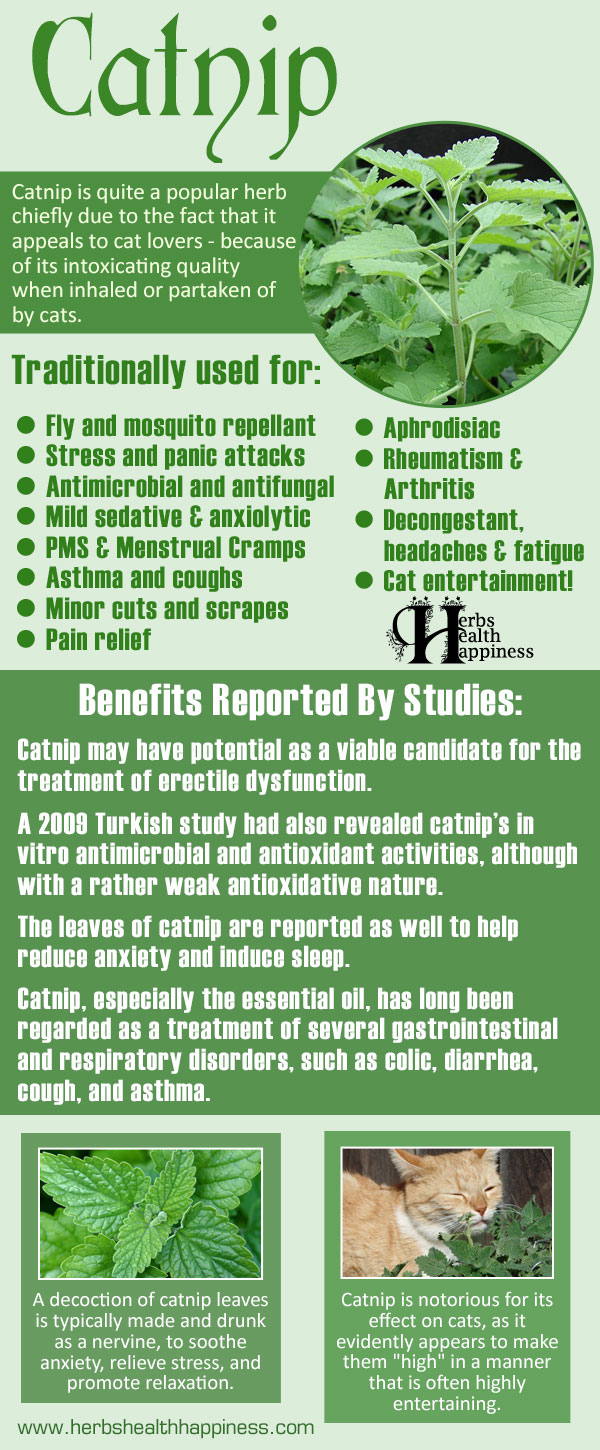Catnip

Uses Of Catnip - image to repin / share
Graphic - herbshealthhappiness.com. Image sources - see foot of article.

Catnip - Botany And History
Catnip is quite a popular herb chiefly due to the fact that it appeals to cat lovers - because of its intoxicating quality when inhaled or partaken of by cats. This unassuming plant typically grows in untended lots or waste places, and measures some fifty to one hundred centimetres tall at the most. Because it is a hardy plant that is commonly found in abandoned places, or else simply shooting up from lawns out of nowhere, it is often considered a weed by unknowing individuals. Considered a native of both Asia and Europe, catnip has become naturalised throughout many areas of the world, especially since it is now widely cultivated primarily for its appeal to pet cats, and (only secondarily) for its medicinal purposes. [1]
While chiefly resembling mint, which is a distant relative of catmint (hence the alternative name of 'catmint'), it is characterised by its greyish-green hued leaves and tiny, clustered flowers of a white hue replete with tiny dots of purple all throughout. While chiefly available in pet stores in already pre-prepared form, catnip is also cultivated by both cat lovers and herbalists alike from seedlings or seeds available nearly everywhere plants are sold. Some wild varietals may even be cultivated and multiplied in any home garden, as the plant is very hardy and not at all difficult to grow. Catnip is notorious for its effect on cats, as it evidently appears to make them "high" in a manner that is often highly entertaining; although it has also been used medicinally by humans since ancient times, a practice which persists to this day.
Catnip - Herbal Uses
The most common use of catnip is as a treat for cats that find its scent and taste highly appealing and pleasurable. Its active compound, nepetalacone, is responsible for the highly alluring appeal that it has over felines. Although it is commonly thought of that all cats (both small and big cats alike) are susceptible to the lure of catnip, it is now understood that only a select population of cats find catnip arousing or appealing, and only if they have inherited the dominant trait from their sires. Nepetalacone is usually imbibed by cats through their Jacobson's organ (medicinally termed 'vomeronasal organ') usually when they accidentally bruise the plants (or when their human friends purposely rub or bruise the leaves for them), which elicits a variety of responses ranging from mild sedation, purring, 'smiling' (aka the 'Flehmen response'), clawing, affectionate rubbing (on the plant), giddiness, general euphoric behavior, arousal, and even aggression. The reactions vary from cat to cat, although one thing is true for cats that are susceptible to catnip – they love it. The effects of catnip usually lasts only for a few minutes, after which the cats become insensate to the plant for at least an hour or two, and then the fun starts again!
When employed for the pleasure of furry friends, one must take note that while catnip is perfectly safe for all cats (including lions, tigers, jaguars, pumas, and every other feline within this sphere of existence), it can encourage aggressive behaviour in some cats which may result in biting, scratching, or general unsavoury behaviour. If catnip causes one's pet to misbehave, discontinuance of use is advised for the safety of both (human and animal) friends and persons. [2]
When used medicinally for human consumption, the leaves of the catnip more than any other part of the plant is typically employed, usually by being made into decoctions or, if dried, made into infusions. It may even be powdered (when dried) and encased in veggie or gelatin capsules, to be taken orally for faster results. In the simplest application, a decoction of catnip leaves is typically made and drunk as a nervine, to soothe anxiety, relieve stress, and promote relaxation. [3] Just as in cats, catnip also has a soothing and sedative quality when drunk by humans. Because it is a distant relative of the mint family, catnip also works as an excellent stomachic, especially when drunk after heavy meals, as it not only soothes the stomach, but also facilitates in faster and easier digestion. [4] Due to its distinct aroma, sipping hot catnip tea while inhaling its fumes may help to alleviate the symptoms of migraines and headaches while enveloping one with a sense of calm.
The fresh leaves may be crushed or bruised and used as an antimicrobial rub or poultice for minor cuts and abrasions, as well as for larger wounds as it not only facilitates in faster healing, but it also staves off infection. The fresh leaves may even be chewed to help relieve the symptoms of toothaches, or a very strong decoction of the leaves (either dry or fresh) may be made into a gargle taken after each meal. Catnip tisanes are perfect for small children who suffer from colic, and since the tea can be somewhat unpalatable for children, mixing it with honey (for children aged 10+) or integrating it into their milk bottle (two to three tablespoons mixed into a full bottle of formula milk or pumped mother's milk). Because of its soothing and sedative properties, strong decoctions of catnip make for the perfect before-bed drink, especially if mixed with lavender and chamomile. [4] This concoction also works well to alleviate panic attacks and general stress and is perfect for soothing hyperactive children. Taken in moderation, catnip may even help to boost the body's immune system and protect it from common diseases like fevers and flu. Catnip also acts as an excellent detoxifier, as it's diuretic and warming properties help to flush out the nasties that have been accumulating in the body easily and safely.
A poultice made from the fresh leaves can also be applied to rheumy parts to provide pain-relief. Further efficiency is achieved if one mixes ginger, chili, or turmeric along with the catnip for a truly penetrating relief for rheumatism and arthritis. It is best applied heated or warm, although applying it fresh from the mortar and pestle works just as well. Very potent decoctions of catnip may even be used as a vermicide or parasiticide in much the same way as wormwood or anise, although great care / expert guidance should be taken when using the herb for such purposes as there can be some unpleasant side-effects. When drunk in controlled doses twice or thrice a week, catnip tisanes may even work as a general tonic. It works best for women as it not only relieves the symptoms of PMS and helps to relieve anxiety and stress, but it also helps regulate menstruation and help ease cramps. [5]
Catnip may be integrated into warm baths either by adding dried leaves unto the warm or tolerably hot bathwater, or by boiling a very strong decoction of the leaves and mixing it with one's bathwater to create a lukewarm bath. It is an effective means to unwind as well as to soothe sore and aching muscles. A tincture of catnip leaves may even be made by mixing dried catnip leaves with 90% proof vodka or cognac and allowing it to macerate for a couple of weeks, shaking regularly. This tincture may then be used (in very minute and diluted amounts) as a general tonic, nervine, or emmenagogue.

Catnip - illustration from an old book
Dried catnip leaves can even be smoked either by itself or mixed with other smokable herbs such as vervain, and even (de facto) tobacco. When smoked, catnip not only promotes a sense of calm and a temporary 'high', it is also believed to promote better, more restful sleep as well as lucid dreams. Smoking catnip may also bring about a feeling of coolness that spreads all throughout the body, not unlike the feeling of smoking menthol-tipped cigarettes, but with a more intense minty feel. Smoking catnip may even bring about a certain feeling of euphoria, or a sense of time slowing down. This 'slowing down' of one's external sense of time includes slower reaction time, a feeling of 'floating' and a sense of everything being in 'slo-mo'. If smoking catnip, it is therefore advisable to refrain from any activity which may require fast reflexes such as driving or the operation of heavy machinery, as catnip may impair one's performance.
Dried catnip leaves may be burnt as an incense to make an all-natural 100% effective insect repellant that deters flies, roaches, mosquitoes, and many other common pests. The essential oil of catnip (which is obtained through steam distillation) may be burnt in an oil diffuser to achieve the same insect repellant effect. It may even be added into a pan of hot water and inhaled to help relieve the symptoms of stuffy nose, as well as to ease the pain of headaches, relieve nausea, and alleviate the dragging feeling of fatigue. [5]
Catnip – Scientific Studies And Research
Catnip as aphrodisiac: A 2011 research study had revealed the positive effect of catnip (Nepeta cataria) on the sexual behavior of rats. In this study, male rats were fed with food added with 10% catnip leaves for 4 hours and were monitored for general activity and motor coordination. Results had demonstrated that catnip consumption increases male rat sexual behavior, which is closely linked with the dopaminergic system. [1] Catnip thus may have potential as a viable candidate for the treatment of erectile dysfunction. [2]

Catnip as antimicrobial: A 2009 Turkish study had also revealed catnip’s in vitro antimicrobial and antioxidant activities, although with a rather weak antioxidative nature. In this study, the antimicrobial and antioxidant activities of the essential oil and methanol extract from catnip as well as its essential oil composition were explored. The results showed that catnip essential oil worked against eleven bacteria species and twelve fungi species, including a yeast (Candida albicans), whereas catnip methanol extract displayed a weaker activity. [3] Moreover, in another separate earlier study that focused on 44 Staphylococcus aureus strains (some resistant to meticillin), the extract from catnip has also been determined to exhibit inhibitory effects on the DNAse, thermonuclease, and lipase of Staphylococcus aureus at concentrations equal to 1/2 and 1/4 MIC. [4]
Catnip for gastrointestinal and respiratory issues: Catnip, especially the essential oil, has long been traditionally regarded as an alternative treatment of several gastrointestinal and respiratory disorders, such as colic, diarrhea, cough, and asthma. Catnip exerts spasmolytic and myorelaxant actions through a blocking activity on the calcium channels and inhibition of phosphodiesterase. Pharmacological and clinical evidence for this has been provided by Gilani et al.’s (2009) study wherein the essential oil Nepeta cataria L. (Limiaceae) was chemically analyzed. [5]
Catnip as anxiolytic: The leaves of catnip are reported as well to help reduce anxiety and induce sleep. [6] In a study by Sherry and Hunter (1979), at low and moderate dose levels (i.e., 25–1800 mg/kg), the alcohol extract of catnip induced sleep among a good number of chicks. [7] Nepetalactone is chiefly responsible for the mild sedative property of catnip. [8]
Catnip – Active Ingredients / Phytochemistry
Adiguzel et al. (2009) isolated the following main components from the essential oil of catnip:
4aalpha,7alpha,7abeta-nepetalactone (70.4%)
4aalpha,7alpha,7abeta-nepetalactone (6.0%)
thymol (2.3%)
4aalpha,7alpha,
7abeta3-nepetalactone (2.5%) [3]
Gilani et al. (2009), on the other hand, identified four very different major constituents from catnip in their study:
1,8-Cineol (21.00%)
Alpha-humulene (14.44%)
Alpha-pinene (10.43%)
Geranyl acetate (8.21%) [5]
The primary constituent of catnip essential oil is the organic compound nepetalactone, a monoterpenoid that triggers a peculiar response among almost all cats when ingested or inhaled. [8] Hydrogenating nepetalactone yields dihydronepetalactone (DHN) diastereomers, which in turn are effective insect repellents, especially against mosquitoes and flies. [9] At a dosage of 20 mg, catnip essential oil has an average repellency rate of 96% against stable flies (Stomoxys calcitrans (L.)) and an average repellency rate of 79% against houseflies (Musca domestica (L.)). [10] This is medically valuable in the global combat against mosquito-borne diseases such as malaria, dengue fever, and elephantiasis and fly-borne diseases such as dysentery.
Catnip - Esoteric Uses And Lore
In magickal practices, catnip has been used for love spells and lust-charms. It has been used as a magickal herb for women who wish to attract a potential mate, as catnip, when burnt as an incense that is cast all over the person, or otherwise used as a face-wash or rinse is said to increase one's attractiveness. Catnip is usually made into gris-gris pouches and carried by women to attract men (or women) that they desire, as legend has it that the apple of their eye will find them irresistible. Catnip is also employed as an herbal bath, not only to promote relaxation and calm, but to increase attractiveness and seductiveness as well. Sprinkling powdered catnip leaves on the four corners of a bed is said to spice up one's sex-life, as well as ensure their lover's devotion and fidelity! Macerating dried catnip leaves in whiskey or rum and sprinkling the ensuing concoction on one's doorstep under a full moon is said to bring about a lover into one's life within the next twenty one days. Catnip, being a feminine herb, can also be burnt as a soothing and relaxing incense as well as a totemic offering for shamanic magick (working best if one's totem is of the feline family). [6]

Catnip – Contraindications And Safety
Care should be taken when consuming catnip for long periods of time, as excessive consumption of very strong decoctions may act as an abortifacient and may induce premature labour or uteral contractions if taken while pregnant. Pregnant and nursing women are dissuaded from drinking even mild infusions of catnip tea, although inhalants, if partaken only sparingly, are allowable, granted the permission and guidance of an expert herbalist or medical practitioner. This is not medical advice.
Names of Catnip, Past and Present
Chinese: chi hsueh tsao
Spanish: hierba gatera / nebada / menta de gato
Italian: herba catti / herba cataria /
French: cataire / chataire / herbe a chat / herbe aux chats / methe des chats
English: catmint / catnip / catnep / catwort / cat's wort / field balm / cat's heal-all / cat's-play / garden nep / nepeta (adapted) / nep (abbreviation for 'nepeta')
Latin (esoteric): catera menthe /
herbe felixis / neptera
Latin (scientific nomenclature): Nepeta cataria (other nomenclatures exist, with each varietals of catnip having its own distinct nomenclature)
Infographic Image Sources:
https://en.wikipedia.org/wiki/File:Starr_070906-8819_Nepeta_cataria.jpg
https://commons.wikimedia.org/wiki/Category:Nepeta_cataria#/media/File:Catnip_,_Nepeta_cataria.jpg
https://pixabay.com/en/cat-tabby-catnip-cute-sniff-smell-829681/
References:
[1] https://en.wikipedia.org/wiki/Nepeta_cataria
[2] https://www.cat-world.com.au/all-about-catnip
[3] https://www.livestrong.com/article/511243-benefits-of-catnip-tea/
[4] https://www.nutrinews.com/blog/10-healing-benefits-of-catnip-tea/
[5] https://www.rxlist.com/catnip-page2/supplements.htm
[6] https://gypsymagicspells.blogspot.com/2009/01/catnip-magick.html
[7] Bernardi M. M., Kirsten T. B., Lago J. H., Giovani T. M., Massoco Cde O. (2011). Nepeta cataria L. var. citriodora (Becker) increases penile erection in rats. Journal of Ethnopharmacology, 137(3): 1318–1322. doi: 10.1016/j.jep.2011.07.061. Retrieved 27 February 2013 from https://www.ncbi.nlm.nih.gov/pubmed/21843621
[8] Erectile dysfunction (impotence). Retrieved 27 February 2013 from https://www.nhs.uk/conditions/Erectile-dysfunction/Pages/Introduction.aspx
[9] Adiguzel A., Ozer H., Sokmen M., Gulluce M., Sokmen A., Kilic H., Sahin F., & Baris O. (2009). Antimicrobial and antioxidant activity of the essential oil and methanol extract of Nepeta cataria. Polish Journal of Microbiology, 58(1): 69–76. Retrieved 27 February 2013 from https://www.ncbi.nlm.nih.gov/pubmed/19469289
[10] Nostro A., Cannatelli M. A., Crisafi G., & Alonzo V. (2001). The effect of Nepeta cataria extract on adherence and enzyme production of Staphylococcus aureus. International Journal of Antimicrobial Agents, 18(6): 583–585. Retrieved 27 February 2013 from https://www.ncbi.nlm.nih.gov/pubmed/11738350
[11] Gilani A. H., Shah A. J., Zubair A., Khalid S., Kiani J., Ahmed A., Rasheed M., & Ahmad V. U. (2009). Chemical composition and mechanisms underlying the spasmolytic and bronchodilatory properties of the essential oil of Nepeta cataria L. Journal of Ethnopharmacology, 121(3): 405–411. doi: 10.1016/j.jep.2008.11.004. Retrieved 27 February 2013 from https://www.ncbi.nlm.nih.gov/pubmed/19041706
[12] Nepeta cataria. Retrieved 27 February 2013 from https://www.missouribotanicalgarden.org/gardens-gardening/your-garden/plant-finder/plant-details/kc/e433/nepeta-cataria.aspx
[13] Sherry C. J. & Hunter P. S. (1979). The effect of an ethanol extract of catnip (Nepeta cataria) on the behavior of the young chick. Experientia, 35(2): 237–238. Retrieved 27 February 2013 from https://www.ncbi.nlm.nih.gov/pubmed/421844
[14] Nepetalactone. Retrieved 27 February 2013 from https://en.wikipedia.org/wiki/Nepetalactone
[15] Feaster J. E., Scialdone M. A., Todd R. G., Gonzalez Y. I., Foster J. P., Hallahan D. L. (2009) Dihydronepetalactones deter feeding activity by mosquitoes, stable flies, and deer ticks. Journal of Medical Entomology, 46(4): 832–840. Retrieved 27 February 2013 from https://www.ncbi.nlm.nih.gov/pubmed/19645285
[16] Zhu J. J., Zeng X. P., Berkebile D., DU H. J., Tong Y., & Qian K. (2009). Efficacy and safety of catnip (Nepeta cataria) as a novel filth fly repellent. Medical and Veterinary Entomology, 23(3): 209–216. doi: 10.1111/j.1365-2915.2009.00809.x. Retrieved 27 February 2013 from https://www.ncbi.nlm.nih.gov/pubmed/19712151
Main article researched and created by Alexander Leonhardt. Scientific studies and phytochemistry reports by Dan
Ablir.
© herbshealthhappiness.com
If you enjoyed this page:































